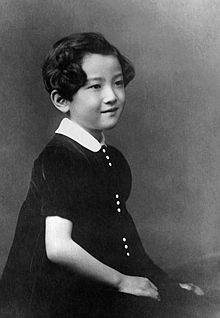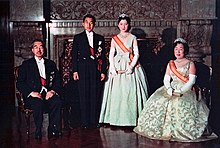Michiko Shōda
Michiko ( Japanese 美智子 Michiko ), born as Michiko Shōda ( 正 田 美智子 Shōda Michiko , born October 20, 1934 in Tokyo ), is empress emeritus of Japan ( 上 皇后 , Jōkōgō ; eng. "Empress Emerita"), wife of the emeritus Tennō (Emperor) Akihito and mother of Emperor Naruhito .
biography
Life before marriage
Michiko was born in Tokyo as the eldest daughter of Hidesaburō Shōda and Fumiko Soejima. She was brought up in the traditional Japanese as well as in the Western way and learned, for example, to speak English , to play the piano and was initiated into the art of painting, cooking and Kōdō . She was the niece of several scientists, including the mathematician Kenjirō Shōda, who served from 1954 to 1960 as the rector of Osaka University .
Michiko attended Futaba Elementary School in Tokyo. However, she had to leave this during the 4th grade due to the increasing number of bombings of Japan during the Second World War by the United States and then attended schools in the prefectures of Kanagawa , Gunma and Nagano . After the defeat of Japan , she attended Seishin Secondary School in Tokyo and left it in 1953. Then she attended the Seishin Girls University ( 聖 心 女子 大学 , University of the Sacred Heart ) in Tokyo, where she received a Bachelor of Arts in English literature in 1957 dropped. She also attended both Harvard University and the University of Oxford .
In her childhood, she was raised by her family in allusion to Shirley Temple "Temple- chan called" because Michiko curly and reddish hair had, which was rather unusual for Japanese girls. After graduating, she got the nickname "Michi". Although she came from a Christian family and attended Christian private schools, she was not baptized .
Because she belonged to a wealthy family, her parents were very picky about a future husband. According to the biographer of the famous author Yukio Mishima , he was one of many interested parties and is said to have been introduced to her.
marriage
In August 1957, Michiko met the then Crown Prince Akihito on a tennis court in the resort of Karuizawa . The Imperial Court Office officially recognized the engagement of Michiko and Akihito on November 27, 1958. This was referred to by the media as the "fairy tale" or "romance of the tennis court". The engagement ceremony took place on January 14, 1959.
As the daughter of a wealthy businessman, Michiko was seen as a commoner. In the 1950s, the media assumed that the court office would choose the daughter of a former nobleman or a distant relative from the imperial family for the crown prince. Some traditionalists were against the engagement because Michiko came from a Roman Catholic family and also recognized the faith of her parents. In addition, it is strongly suspected that the then Empress Kōjun also refused the engagement. After her death in 2000, the Reuters news agency reported that the empress was even one of the greatest opponents of the marriage. She is said to have driven Michiko into depression in the 1960s through constant allegations that she was not the right woman for her son . The authorities also had to ensure the safety of the Shōda family due to death threats.
Despite everything, the young couple received support from the international public and the government. In addition, the young Michiko became a symbol of the modernization and democratization of Japan. At the time, the media referred to the phenomenon as "Michi Boom". The traditional Shinto wedding finally took place on April 10, 1959. The subsequent wedding procession through Tokyo was attended by 500,000 spectators spread over 8.8 kilometers. Much of the wedding was televised, making it the first imperial wedding to be presented to the public. The audience was around 15 million.
Life as a Crown Princess
After the marriage, Akihito and Michiko moved to the Togu Palace in the Akasaka district , southwest of the Imperial Palace . The building was built in 1952 as the residence of the Crown Prince. On February 23, 1960, their first son Naruhito was born. In the imperial family it was customary until now for children to be raised separately from their parents. However, the couple broke that tradition and decided to raise their children themselves. Michiko even breastfed her babies. In 1963 the media reported that on March 22, 1963, she broke off a pregnancy after about three months for health reasons . During her time as Crown Princess, Michiko and her husband visited 37 countries between 1959 and 1989 and also strengthened her public position in Japan, visiting all 47 prefectures. In 1965 their second son Fumihito was born and in 1969 Princess Nori was born .
The Crown Princess suffered mental health problems in the 1960s due to pressures from the media and her mother-in-law, and lost her voice for 7 months.
Life as empress

After the death of Emperor Hirohito on January 7, 1989, Akihito and Michiko ascended the throne. Her official duties as empress included accompanying the emperor to events, ceremonies and trips abroad, receiving state guests and visiting social, cultural and charitable institutions and organizations. She is also Honorary President of the Japanese Red Cross .
As empress, Michiko was also responsible for the silk plantation on the grounds of the imperial palace. They took part in the annual ceremony of the Silk harvest and breeds even silkworm . Growing and harvesting silk was part of their ceremonial duties, which are part of Shintoism and Japanese culture and tradition. Since 1994 the empress donated some of the silk to the Tōdai-ji temple in Nara to restore the treasures of Emperor Shōmu that were there .
As empress, she was expected to carry out the Japanese ideal of women, called Yamato Nadeshiko . She has shown a sense of duty throughout her life, which makes her very popular among the population. Michiko participated with the emperor in religious customs such as visiting Shinto shrines and tombs of the imperial family.
Akihito's abdication
After Emperor Akihito indicated in a televised address that he wanted to abdicate in the near future, the Japanese government decided on December 8, 2017 after consulting the "Imperial Council" ( 皇室 会議 Kōshitsu Kaigi , consisting of Prime Minister Shinzō Abe , the president of the two chambers of the Parliament Tadamori Ōshima and Chūichi Date as well as Naruhito's uncle Prince Masahito of Hitachi and his wife Princess Hanako of Hitachi ) that Emperor Akihito will abdicate on April 30, 2019 and Naruhito will ascend the chrysanthemum throne the following day. Akihito's reign and with it Michiko's office as empress officially ended at 11:59 p.m. local time .
progeny
Michiko has three children with Akihito:
- Emperor Naruhito (born February 23, 1960)
- Prince Akishino (Fumihito; born November 30, 1965)
- Princess Nori (Sayako; born April 18, 1969)
She also has four grandchildren:
- Princess Mako (born October 23, 1991) - daughter of Prince Akishino and his wife Kiko
- Princess Kako (born December 29, 1994) - daughter of Prince Akishino and Kiko
- Princess Aiko (born December 1, 2001) - daughter of Emperor Naruhito and Empress Masako
- Prince Hisahito (born September 6, 2006) - son of Prince Akishino and Kiko
Private
- Michiko is considered a talented piano and tennis player.
- Michiko has a strong interest in gagaku , a style of music that has been played in the imperial family since the 7th century.
- Michiko is enthusiastic about poetry and translated two works by Mado Michio into English. She also wrote several poems herself, including those in the waka style.
Publications
- Poems: Just a little mulberry. But it weighed heavily ; Poems by Michiko, Empress of Japan; with calligraphy by Hakko Ishitobi , translated by Peter Pantzer . Herder, Freiburg im Breisgau 2017, ISBN 978-3-451-31220-5 .
Individual evidence
- ↑ Emperor Akihito to Be Called Emperor Emeritus after Abdication. In: nippon.com. Retrieved April 30, 2019 .
- ↑ 天皇 陛下 退位 「2019 年 4 月 30 日」 政令 を 閣 議 決定 . In: Asahi Shimbun . December 8, 2017. Retrieved December 9, 2017 .
- ↑ This is how this country sparkles in FAZ of November 11, 2017, page 18
Web links
| personal data | |
|---|---|
| SURNAME | Michiko |
| ALTERNATIVE NAMES | 皇后 美智子 (Japanese); Kōgō Michiko; 正 田 美智子 (Japanese, maiden name); Shōda Michiko (maiden name) |
| BRIEF DESCRIPTION | Japanese nobles, empress emeritus of Japan |
| DATE OF BIRTH | October 20, 1934 |
| PLACE OF BIRTH | Tokyo |





